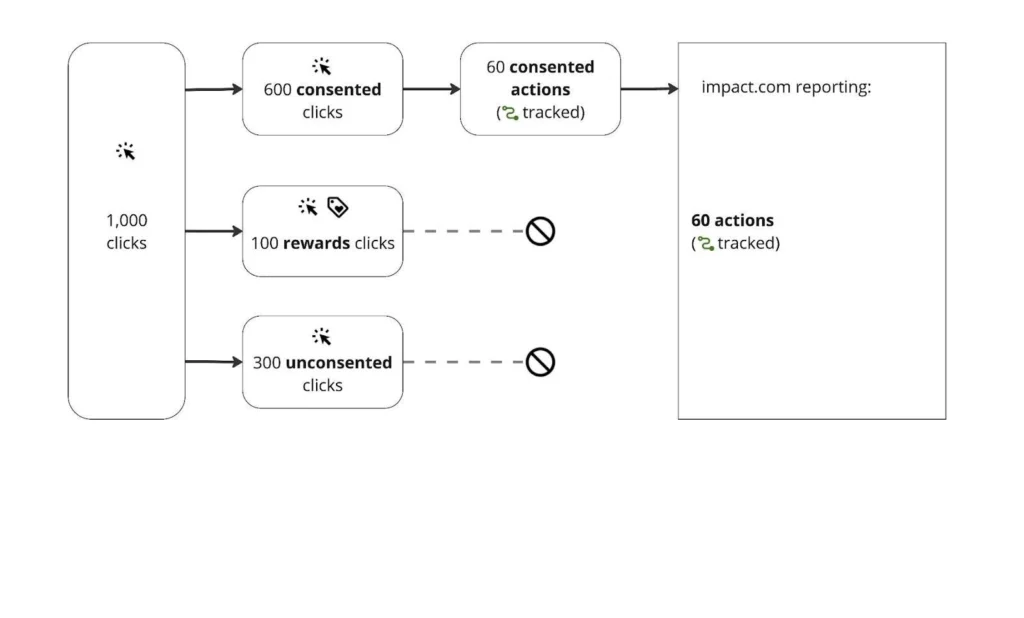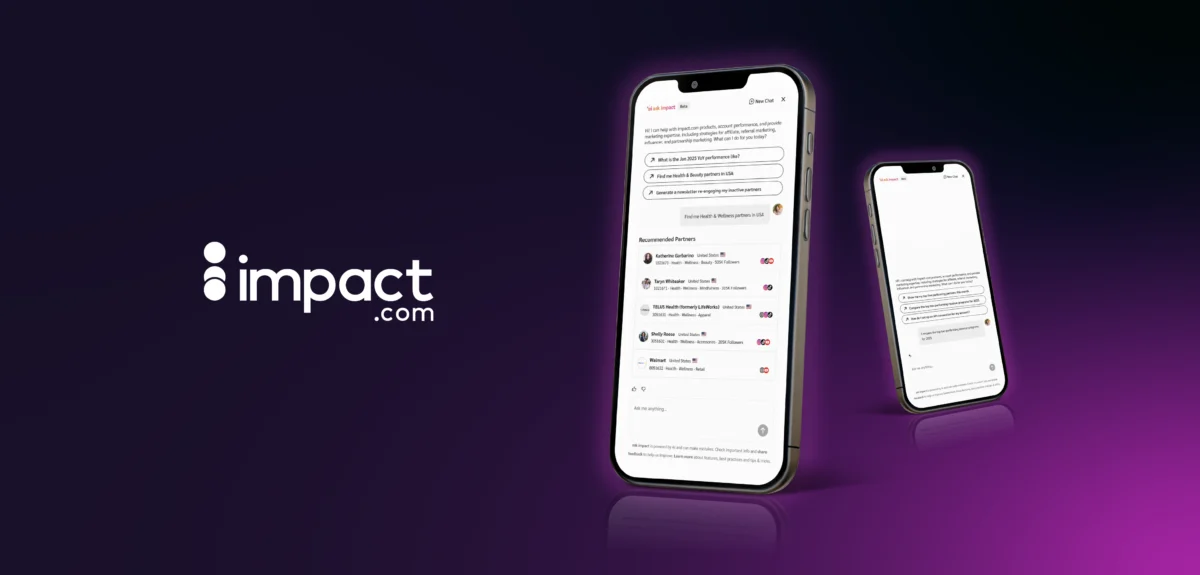If you’re a brand that runs a loyalty or cashback program in a GDPR region, you’re probably dealing with the hassle of the new GDPR rule—having to obtain user consent before placing tracking cookies.
This recent guidance from the UK’s Information Commission’s Office (ICO) has significant implications for how you track and reward user actions. With consent rates declining and privacy regulations tightening, many partnership programs may lose visibility into performance. The result? It could hinder attribution, payouts, and ROI.
Not to worry—there’s a compliant path forward. Learn what the ICO’s ruling means for your partnership tracking strategy and how impact.com’s Consent Mode helps you accurately attribute rewards with privacy top-of-mind.
Understanding the ICO ruling and its impact
Under GDPR rules, brands in the European Economic Area (EEA) must obtain user consent before placing tracking cookies. This makes it difficult for loyalty and cashback programs to accurately attribute conversions, especially with consent rates dwindling. In the UK, roughly 43 percent of consumers aged 18 to 24 and 35 percent of consumers aged 35 to 44 habitually opt out of first-party cookies on websites.

Source: Statistia report
On the plus side, the (ICO) clarifies that tracking for loyalty and rewards programs can be exempt from standard consent requirements. This exemption specifically applies to European Economic Area (EEA) programs. If users are informed that tracking will occur to receive rewards, then giving implicit cookie consent isn’t needed.
Why this matters for your loyalty program
The ICO’s clarification offers a new opportunity and highlights the risks brands face if they don’t act. Without a plan, loyalty and cashback programs will battle to track conversions due to low consent rates and restricted cookie use.
These gaps have real business consequences:
- Lost attribution for valid conversions: If consent isn’t captured, the transaction may go untracked, leading to missed rewards and payout errors.
- Underreported program value: Inaccurate tracking makes it harder to prove ROI and justify program investment.
- Revenue loss for publishers: Partners lose commission on referred actions that aren’t properly credited, impacting long-term relationships.
- Poor user experience: Customers get frustrated when rewards aren’t tracked, damaging brand trust and reducing engagement.
- Increased support volume: Tracking issues results in more inquiries, investigations, and manual resolution efforts.
The upside of getting consent right
Using a privacy-compliant tracking solution like impact.com’s Consent Mode can lead to increases in conversions, better attribution, and fewer support tickets. You can optimize program performance and deliver a smoother experience to partners and users with improved visibility.
What is Consent Mode and how does it work?
Consent Mode is an impact.com feature (currently in beta) that helps brands maximize tracking and attribution in regions where tracking requires user consent, such as GDPR areas.
The feature gives publishers a simple way to mark any given link as a rewards link (making it exempt from the normal consent requirements).
When a publisher adds “im_rewards=1” to their tracking link, the impact.com system knows to track that user journey, ignoring consent status.
Imagine we start with 1,000 clicks. In GDPR countries, when consent is required, we’ll track and attribute only the clicks for which the user provided consent. In this example, around 40 percent of clicks don’t become attributable. In reality, this can be as high as 80-90 percent.
Tracking without Consent Mode

Diagram 1: The number of trackable links without Consent Mode
Without Consent Mode, you can see 600 consented clicks–these are the only trackable ones. Additionally, the unconsented reward and non-reward clicks are treated similarly and therefore not tracked.
Tracking with Consent Mode

Diagram 2: The number of trackable links with Consent Mode
Using Consent Mode, brands can track the 500 consented clicks and the 200 rewards (700 total), even though these clicks are a mix of consented and unconsented. So, if we compare Diagram 1 with Diagram 2, we can see that using Consent Mode gives us access to 100 more trackable links.
Consent Mode categorizes these 1,000 clicks into three groups:
- Consented clicks: Out of 1,000 clicks, 500 are consented. These clicks yield 50 consented actions, all accurately tracked in our reporting.
- Rewards clicks: Rewards clicks are a distinct category because they represent a service the user requests and don’t require consent for tracking. We have 200 clicks from rewards programs, translating into 20 rewards actions, also fully tracked with Consent Mode.
- Unconsented clicks: From 300 unconsented clicks, we can model an additional 10 actions. Consent mode collects additional signals to accurately model these actions. In the near future, impact.com will have this feature to provide even greater granular detail.
Thanks to Consent Mode, this reporting reflects 70 tracked actions from consented and rewards clicks. With the upcoming consent modeling feature, we’ll begin modeling actions from unconsented clicks, allowing us to predict how many valid actions weren’t tracked due to nonconsent.
Results and performance metrics
Stay ahead of metrics with impact.com’s Consent Mode. This feature lets you improve program performance while respecting user privacy.
Key metrics to track:
- Before/after conversion rates: Measure how conversion rates change once Consent Mode is implemented, particularly from previously untracked or misattributed actions.
- Performance improvements: Track the increase in conversions generated by your loyalty and rewards publishers.
- Program efficiency gains: Assess the reduction in manual tracking adjustments and support escalations.
Real program impacts:
- Higher conversion volumes: More accurate tracking leads to better reward attribution and higher conversion rates.
- Improved publisher satisfaction: Publishers are more likely to promote programs that accurately track and reward actions.
- Reduced support tickets: Fewer tracking issues mean lower support volume and faster resolution times.
- Better user experience: Customers benefit from consistent and accurate reward fulfillment, increasing engagement.
Get started with Consent Mode for advanced partnership tracking and compliance
Before you hit the ground running with Consent Mode, ensure you meet these requirements:
- Have partners in GDPR regions: If you generate traffic and sales from partnerships in GDPR regions, you can use Consent Mode.
- Have partnerships with loyalty or reward publishers: Consent Mode is specifically designed for brands with partnerships with loyalty and reward publishers.
Consent Mode only works when both brands and their partners are on board. Encourage all partners you work with to enable Consent Mode in impact.com for maximum impact.
The more participants who implement Consent Mode, the better your tracking coverage and data quality will be.
No ticket is needed to activate Consent Mode. You can follow a simple, self-service integration process.
Here are some resources to help you get started:






